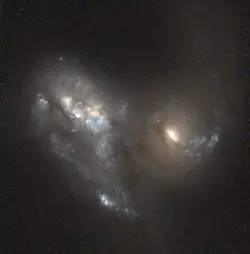NGC 7592
NGC 7592 is an interacting galaxy system located 300 million light years away in the constellation Aquarius. It was discovered by William Herschel on September 20, 1784.[3] The total infrared luminosity is 1011.33 L☉, and thus it is categorised as a luminous infrared galaxy.[4] One of the galaxies hosts a type 2 Seyfert nucleus.[5]
| NGC 7592 | |
|---|---|
 | |
| Observation data (J2000 epoch) | |
| Constellation | Aquarius |
| Right ascension | 23h 18m 22.2s[1] |
| Declination | −04° 25′ 01″[1] |
| Redshift | 0.024444 ± 0.000113 |
| Helio radial velocity | 7,328 ± 34 km/s[1] |
| Distance | 306 Mly (95 Mpc)[1] |
| Apparent magnitude (V) | 13.5[2] |
| Characteristics | |
| Type | S0+ pec[1] |
| Apparent size (V) | 1′.2 × 0′.9[1] |
| Notable features | mergering galaxy pair |
| Other designations | |
| MCG -01-59-017, VV 731, PGC 70999,[1] Mrk 928 | |
Characteristics
NGC 7592 is an interacting galaxy system and ongoing galaxy merger between an early type galaxy and a late type spiral galaxy.[6] The system has at least two faint diffuse tidal tails, with the longer one extending about 2 arcminutes towards the south.[7] Based on the total infrared luminosity of the galaxy (1011.33 L☉), NGC 7592 is categorised as a luminous infrared galaxy.[8] Luminous infrared galaxies are characterised by increased star formation. The star formation rate of NGC 7592 is estimated to be 26 M☉ per year.[7]
Nuclei
The two galactic nuclei, whose projected separation is 14 arcseconds, have nearly equal luminance in near infrared imaging.[9] The west nucleus is known to be a Seyfert, a type of active galactic nucleus (AGN). Based on its spectral lines, it has been categorised as type 1.9 or type 2.[10] The most accepted theory for the energy source of AGNs is the presence of an accretion disk around a supermassive black hole. It has been suggested that around the Seyfert nucleus lies a rotating, star-forming knotty disk or ring with a diameter of about 1.5 kpc viewed nearly edge-on, and which is perpendicular to the galactic plane. It is possible that it is material accreted from the other galaxy. The east nucleus features a complex structure, probably due to extinction.[6] There is diffuse X-ray emission around both nuclei.[7]
At the end of one tidal tail lies a bright source in visual light that is identified as NGC 7592C.[7] It is located about 12 arcseconds south from the mid-distance of the two other nuclei.[9] It has been suggested that it is another galaxy taking part in the merger, however its infrared emission is fainter than the other two nuclei and it hasn't been detected in x-rays by Chandra X-ray Observatory.[11] Its spectrum, both optical and infrared, suggests it is an extranuclear star formation region.[7] Based on its kinematics, the south condensation is part of the spiral galaxy.[6]
See also
- NGC 5256 - a similar interacting galactic pair
References
- "NASA/IPAC Extragalactic Database". Results for NGC 7592. Retrieved 2020-11-03.
- "Revised NGC Data for NGC 7592". spider.seds.org. Retrieved 25 November 2018.
- Seligman, Courtney. "NGC 7592 (= PGC 70999)". Celestial Atlas. Retrieved 19 November 2018.
- Sanders, D. B.; Mazzarella, J. M.; Kim, D.-C.; Surace, J. A.; Soifer, B. T. (October 2003). "The IRAS Revised Bright Galaxy Sample". The Astronomical Journal. 126 (4): 1607–1664. arXiv:astro-ph/0306263. Bibcode:2003AJ....126.1607S. doi:10.1086/376841. S2CID 14825701.
- Maia, Marcio A. G.; Machado, Rodolfo S.; Willmer, Christopher N. A. (October 2003). "The Seyfert Population in the Local Universe". The Astronomical Journal. 126 (4): 1750–1762. arXiv:astro-ph/0307180. doi:10.1086/378360.
- Hattori, Takashi; Yoshida, Michitoshi; Ohtani, Hiroshi; Ishigaki, Tsuyoshi; Sugai, Hajime; Hayashi, Tadashi; Ozaki, Shinobu; Ishii, Motomi (25 June 2002). "Tridimensional Spectroscopic Observation of the Interacting System NGC 7592". Publications of the Astronomical Society of Japan. 54 (3): 393–404. doi:10.1093/pasj/54.3.393.
- Smith, Beverly J.; Campbell, Kristen; Struck, Curtis; Soria, Roberto; Swartz, Douglas; Magno, Macon; Dunn, Brianne; Giroux, Mark L. (23 January 2018). "Diffuse X-Ray-emitting Gas in Major Mergers". The Astronomical Journal. 155 (2): 81. doi:10.3847/1538-3881/aaa1a6. hdl:20.500.11937/66900.
- Sanders, D. B.; Mazzarella, J. M.; Kim, D.-C.; Surace, J. A.; Soifer, B. T. (October 2003). "The IRAS Revised Bright Galaxy Sample". The Astronomical Journal. 126 (4): 1607–1664. arXiv:astro-ph/0306263. Bibcode:2003AJ....126.1607S. doi:10.1086/376841. S2CID 14825701.
- Haan, S.; Armus, L.; Laine, S.; Charmandaris, V.; Smith, J. D.; Schweizer, F.; Brandl, B.; Evans, A. S.; Surace, J. A.; Diaz-Santos, T.; Beirão, P.; Murphy, E. J.; Stierwalt, S.; Hibbard, J. E.; Yun, M.; Jarrett, T. H. (1 December 2011). "Spitzer IRS spectral mapping of the Toomre sequence: spatial variations of PAH, gas, and dust properties in nearby major mergers". The Astrophysical Journal Supplement Series. 197 (2): 27. doi:10.1088/0067-0049/197/2/27.
- Rafanelli, Piero; Marziani, Paolo (March 1992). "The complex nature of the interacting system NGC 7592". The Astronomical Journal. 103: 743. doi:10.1086/116098.
- Torres-Albà, N.; Iwasawa, K.; Díaz-Santos, T.; Charmandaris, V.; Ricci, C.; Chu, J. K.; Sanders, D. B.; Armus, L.; Barcos-Muñoz, L.; Evans, A. S.; Howell, J. H.; Inami, H.; Linden, S. T.; Medling, A. M.; Privon, G. C.; U, V.; Yoon, I. (1 December 2018). "C-GOALS - II. Chandra observations of the lower luminosity sample of nearby luminous infrared galaxies in GOALS". Astronomy & Astrophysics. 620: A140. doi:10.1051/0004-6361/201834105.
External links
 Media related to NGC 7592 at Wikimedia Commons
Media related to NGC 7592 at Wikimedia Commons
- NGC 7592 on WikiSky: DSS2, SDSS, GALEX, IRAS, Hydrogen α, X-Ray, Astrophoto, Sky Map, Articles and images